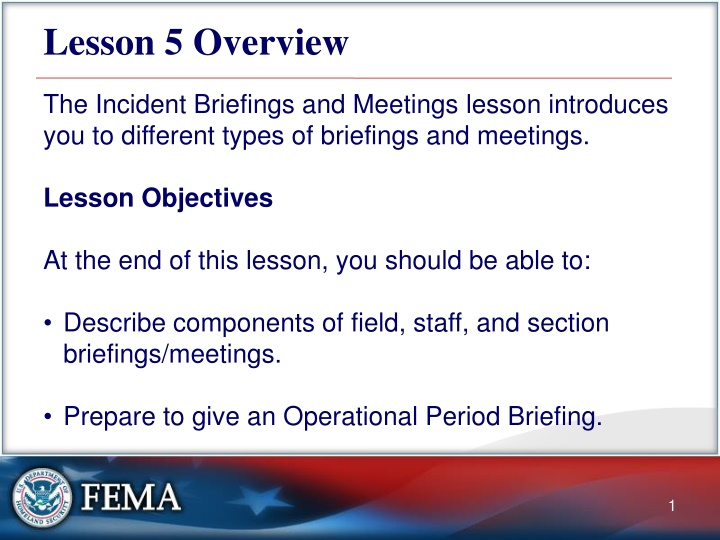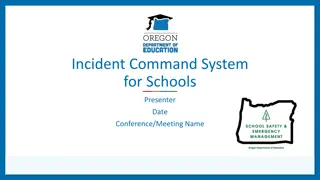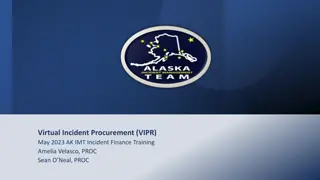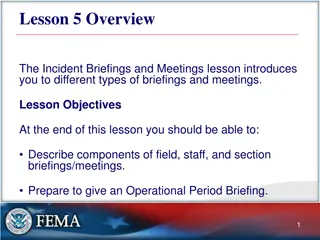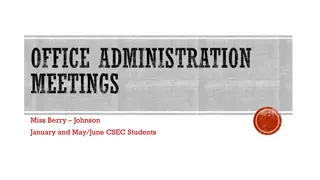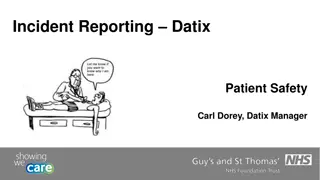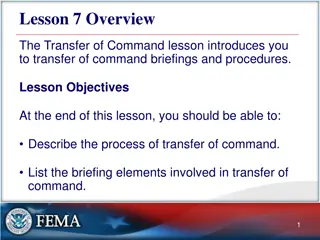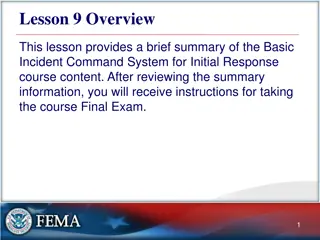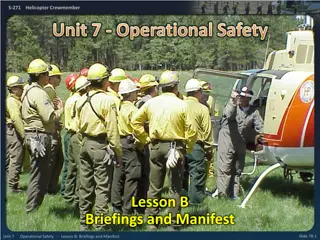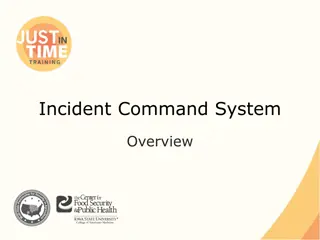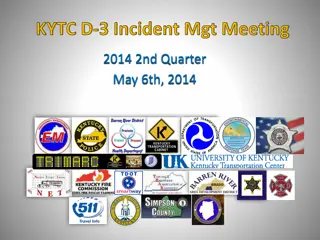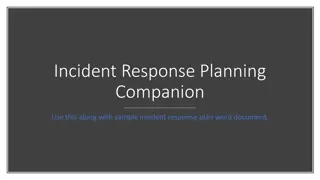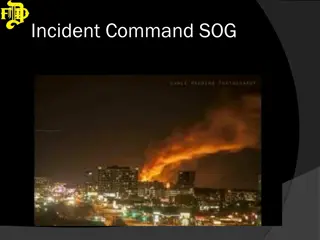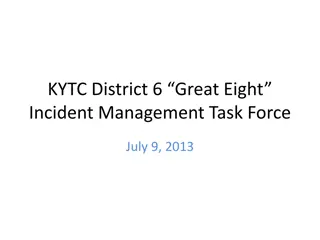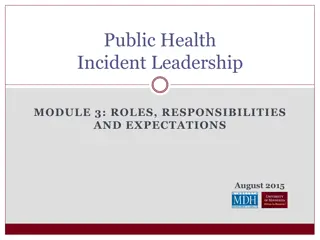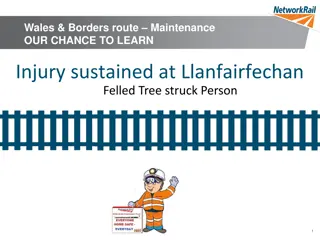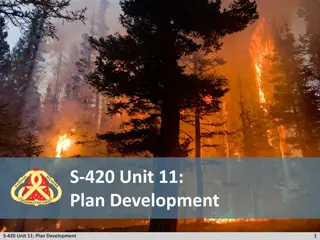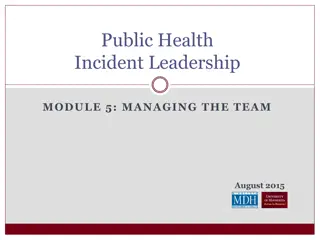Effective Incident Briefings and Meetings Overview
This lesson covers various types of briefings and meetings within the Incident Command System (ICS), including field, staff, and section briefings. It explores the Incident Action Planning Process for developing the IAP, emphasizing the importance of effective communication in incident management. Topics include levels of briefings, components of meetings, and the essential elements of effective briefings. Students engage in activities to practice preparing for incident briefings.
Download Presentation

Please find below an Image/Link to download the presentation.
The content on the website is provided AS IS for your information and personal use only. It may not be sold, licensed, or shared on other websites without obtaining consent from the author.If you encounter any issues during the download, it is possible that the publisher has removed the file from their server.
You are allowed to download the files provided on this website for personal or commercial use, subject to the condition that they are used lawfully. All files are the property of their respective owners.
The content on the website is provided AS IS for your information and personal use only. It may not be sold, licensed, or shared on other websites without obtaining consent from the author.
E N D
Presentation Transcript
Lesson 5 Overview The Incident Briefings and Meetings lesson introduces you to different types of briefings and meetings. Lesson Objectives At the end of this lesson, you should be able to: Describe components of field, staff, and section briefings/meetings. Prepare to give an Operational Period Briefing. 1
Incident Action Planning Process The Incident Action Planning Process defines the progression of meetings and briefings utilized to develop the IAP that is used for the Operational Period Briefing. In addition to these IAP related meetings, there will also be other meetings and briefings within the ICS organization to include section-level meetings and briefings, situation update briefings, and transfer of command briefings. 2
Effective Meetings and Briefings Effective briefings and meetings are: An essential element to good supervision and incident management Intended to pass along vital information required in the completion of incident response actions Typically, these briefings are concise and do not include long discussions or complex decision-making. Rather, they allow incident managers and supervisors to communicate specific information and expectations for the upcoming work period and to answer questions. 3
Levels of Briefings There are three types of briefings/meetings used in ICS: staff level, field level, and section level. Staff-level briefings are delivered to resources assigned to nonoperational and support tasks at the Incident Command Post or Base. Field-level briefings are delivered to individual resources or crews who are assigned to operational tasks and/or work at or near the incident site. Section-level briefings are delivered to an entire Section and include the Operational Period Briefing. 4
ACTIVITY 5.1: BRIEFING INFORMATION Activity Purpose: To give students practice at determining the appropriate details required when preparing for an incident briefing and identifying information pertinent to the audience to be covered in the briefing. Time: 15 minutes Instructions: Working in your group: 1. Review your assigned type of briefing (staff, field, section). 2. For the assigned type of briefing, list the specific types of information that you think should be in briefings. You may want to refer to the two previous visuals. 3. Choose a spokesperson to present your findings to the class. Be ready to present your list in 10 minutes. 5
Briefing Topics Checklist Below is a list of topics that you may want to include in a briefing. Current Situation and Objectives Safety Issues and Emergency Procedures Work Tasks Facilities and Work Areas Communications Protocols Supervisory/Performance Expectations Process for Acquiring Resources, Supplies, and Equipment Work Schedules Questions or Concerns 6
Staff-Level Briefing Topics Work area Communication protocol within the unit Safety issues and emergency procedures Expectations: Specific tasks for the work period Meeting attendance and schedule Coworkers, subordinates Quantity and quality of work Process to obtain additional resources, supplies, and equipment Timelines Schedule for updates and completed products Shift or work period schedule 7
Field-Level Briefing Topics Work area Coworkers, subordinates, supervisor, and adjoining forces Scope of responsibility Safety issues and emergency procedures Process to obtain additional resources, supplies, and equipment Specific tasks for the work period Shift or work period schedule Communication channels and protocols Expectations 8
Section-Level Briefing Topics Scope Process to obtain additional resources, supplies, and equipment Section organization Work site/area/facility layout Expectations Scope of responsibility and delegated authority Safety issues and emergency procedures Staff introductions Section meetings schedule 9
Operational Period Briefing The Operational Period Briefing: Is conducted at the beginning of each operational period. Presents the Incident Action Plan for the upcoming period to supervisory personnel within the Operations Section. Should be concise. In addition to the Operations Section Chief, the other members of the Command and General Staffs as well as specific support elements (i.e., Communications Unit, Medical Unit) can provide important information needed for safe and effective performance during the operational period. 10
Operational Period Briefing: Agenda The Operational Period Briefing is facilitated by the Planning Section Chief and follows a set agenda. A typical briefing includes the following: The Planning Section Chief reviews the agenda and facilitates the briefing. The Incident Commander or Planning Section Chief presents incident objectives or confirms existing objectives. The Planning Section (Situation Unit Leader) provides information on the current situation. The current Operations Section Chief provides current assessment and accomplishments. The on-coming Operations Section Chief covers the work assignments and staffing of Divisions and Groups for the upcoming operational period. The Logistics Section Chief provides updates on transportation, communications, and supplies. The Finance/Administration Section Chief provides any fiscal updates. The Public Information Officer provides information on public information issues. The Liaison Officer briefs any interagency information. 11
Operational Period Briefing: Agenda (Continued) Technical Specialists present updates on conditions affecting the response (weather, fire behavior, environmental factors). The Safety Officer reviews specific risks to operational resources and the identified safety/mitigation measures. Supervisors of specialized functions such as Intelligence/Investigations or Air Operations brief on their area (if activated). The Incident Commander reiterates his or her operational concerns and directs resources to deploy. The Planning Section Chief announces the next Planning Meeting and Operational Period Briefing, then adjourns the meeting. 12
ACTIVITY 5.2: OPERATIONAL PERIOD BRIEFING Activity Purpose: To give students practice at preparing and presenting briefings. Time: 55 minutes Instructions: Working in your team: 1. Prepare an operational period briefing using the information from the Emerald City Flood scenario begun in the previous units. 2. Include the following roles: Incident Commander Planning Section Chief Operations Section Chief (assume no change of command) Safety Officer Weather Specialist 3. Be prepared to present your briefing in 20 minutes. 13
Lesson Completion You have completed the Briefings lesson. You should now be able to: Describe components of field, staff, and section briefings/meetings. Prepare to give an Operational Period Briefing. The next lesson will discuss organizational flexibility. 14
